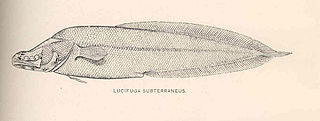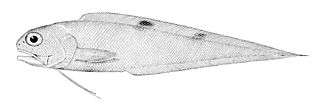
The viviparous brotulas form a family, the Bythitidae, of ophidiiform fishes. They are known as viviparous brotulas as they generally bear live young, although there are indications that some species do not. They are generally infrequently seen, somewhat tadpole-like in overall shape and mostly about 5–10 cm (2–4 in) in length, but some species grow far larger and may surpass 60 cm (2 ft).

Lucifuga is a genus of viviparous brotulas. Most of the species are native to caves and sinkholes in Cuba and the Bahamas; L. inopinata from deep water off the Galápagos Islands is the only exception. The four species rated by the IUCN are all considered vulnerable. The largest species in the genus reaches about 15 cm (5.9 in) in length.

Ogilbia is a genus of viviparous brotulas. The generic name honours the Australian naturalist James Douglas Ogilby (1853-1925), for his contribution to the knowledge of the fishes of Australia.
Parasaccogaster melanomycter is a species of viviparous brotula endemic to Colombia.

Saccogaster is a genus of viviparous brotulas. They are found in the western Atlantic and Indo-Pacific.
Alionematichthys is a genus of viviparous brotulas.
Beaglichthys is a genus of viviparous brotulas.
Diancistrus is a genus of viviparous brotulas.
Didymothallus is a genus of viviparous brotulas found in the Indian and western Pacific Oceans.
Ogilbichthys is a genus of viviparous brotulas found in the central-western Atlantic Ocean and the Caribbean Sea. he generic name refers to the resemblance of these fish to those in the genus Ogilbia, a name honours the Australian naturalist James Douglas Ogilby (1853-1925), combined with ichthys which means "fish" in Greek.
Paradiancistrus is a genus of viviparous brotulas.
Timorichthys is a genus of viviparous brotulas so far known from the East China Sea and the Timor Sea.
Tuamotuichthys is a genus of viviparous brotulas found in the Pacific Ocean.

Neobythites is a genus of cusk-eels.

Otophidium is a genus of cusk-eels, part of the subfamily Ophidiinae in the family Ophidiidae. They are found in the western Atlantic and eastern Pacific.

Sirembo is a genus of cusk-eels of the subfamily Neobythitinae, family Ophidiidae, which are found in the Indian and Pacific Oceans. The species in this genus have a rather robust body with the dorsal fin originating over vertebrae 1–5. The head and bod are completely covered in scales, they have large eyes which are almost equal in diameter to the length of snout, the pelvic fins have two rays which are joined together within an area of tough skin, They have a short spine on the operculum which does not extend to the posterior edge of the head. Their coloration is variable but almost all species have black spots or eyespots on the dorsal fin, sometimes both, while the middle part of the anal fin frequently has a black band. The body and/or head are marked with diagonal or horizontal dark stripes or horizontal rows of quite large dusky spots.
Spottobrotula is a genus of cusk-eels.
Grammonus waikiki, or the Waikiki viviparous brotula, is a species of viviparous brotula found in the Hawaiian Islands where it occurs at depths of around 3–18 metres (9.8–59.1 ft).

Brosmophycinae is a subfamily of the viviparous brotulas. They are divided from the subfamily Bythitinae by having the dorsal fin, caudal fin and anal fin all separate whereas they are joined in the Bythitinae. It is divided into the tribes Dinematichthyini and Brosmophycini, with the first having hardened genital claspers and the second soft genital claspers. A review in 2016 elevated the Dinematichthyini to the status of a family the Dinematichthyidae.

Bythitinae is a subfamily of viviparous brotulas, one of the two subfamilies in the family Bythitidae. This subfamily is characterised by having the dorsal, caudal and anal fins combined. They are mostly found in temperate to tropical seas, from reefs to the benthopelagic zone, but some species from the North Atlantic Ocean occur in into Arctic waters.







